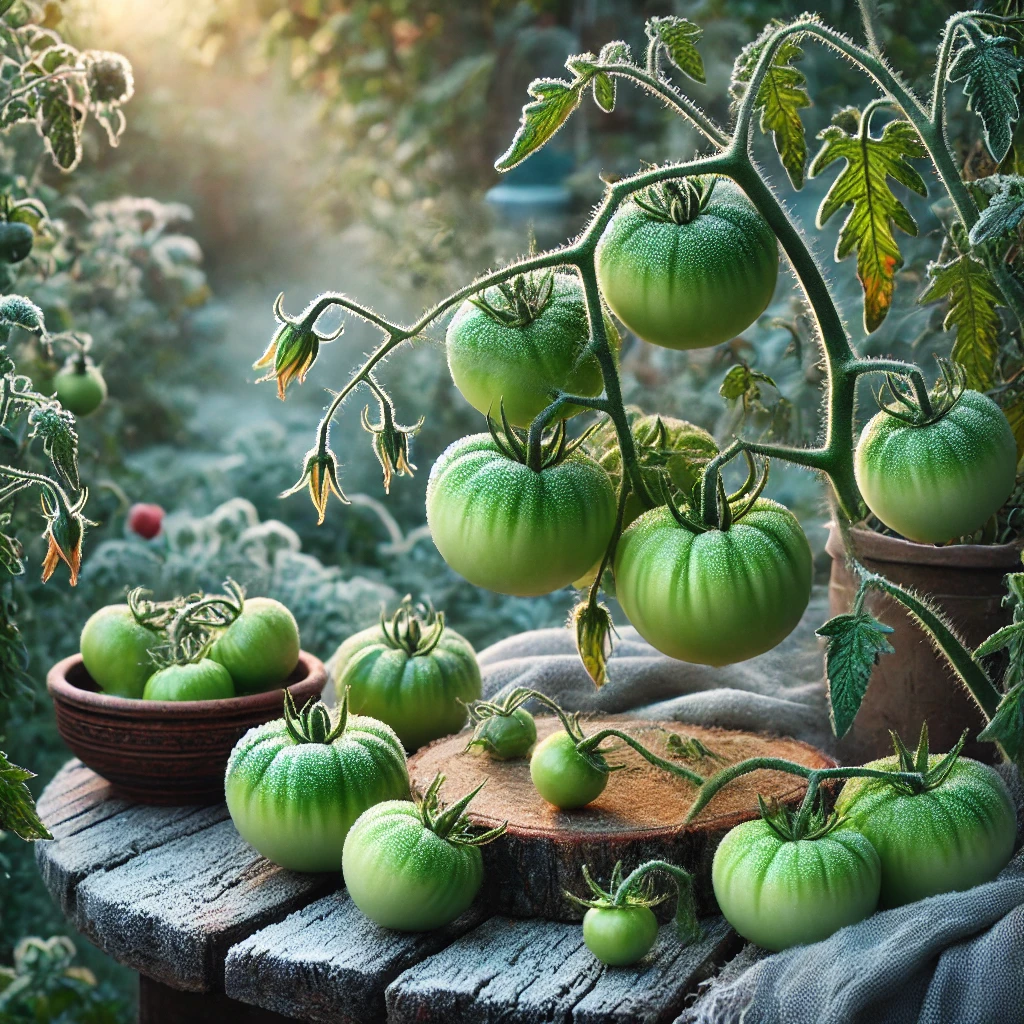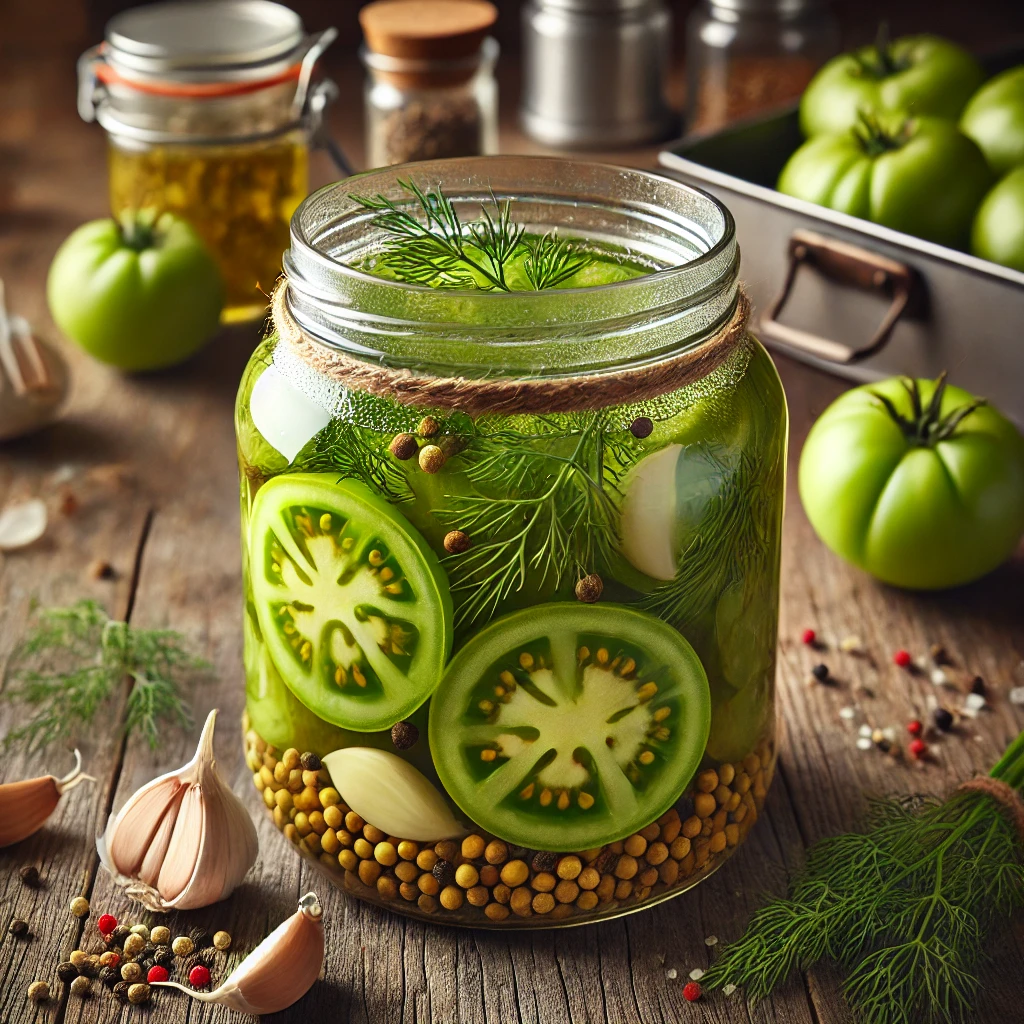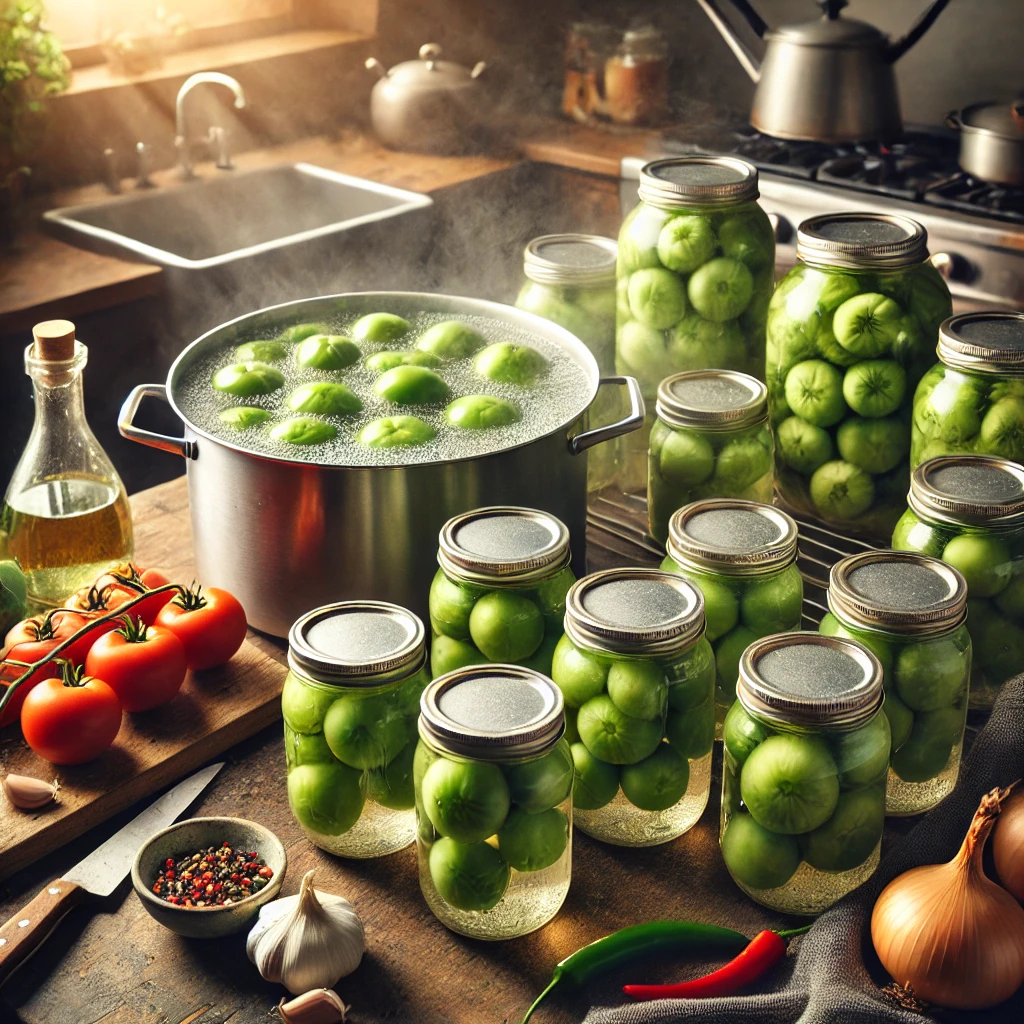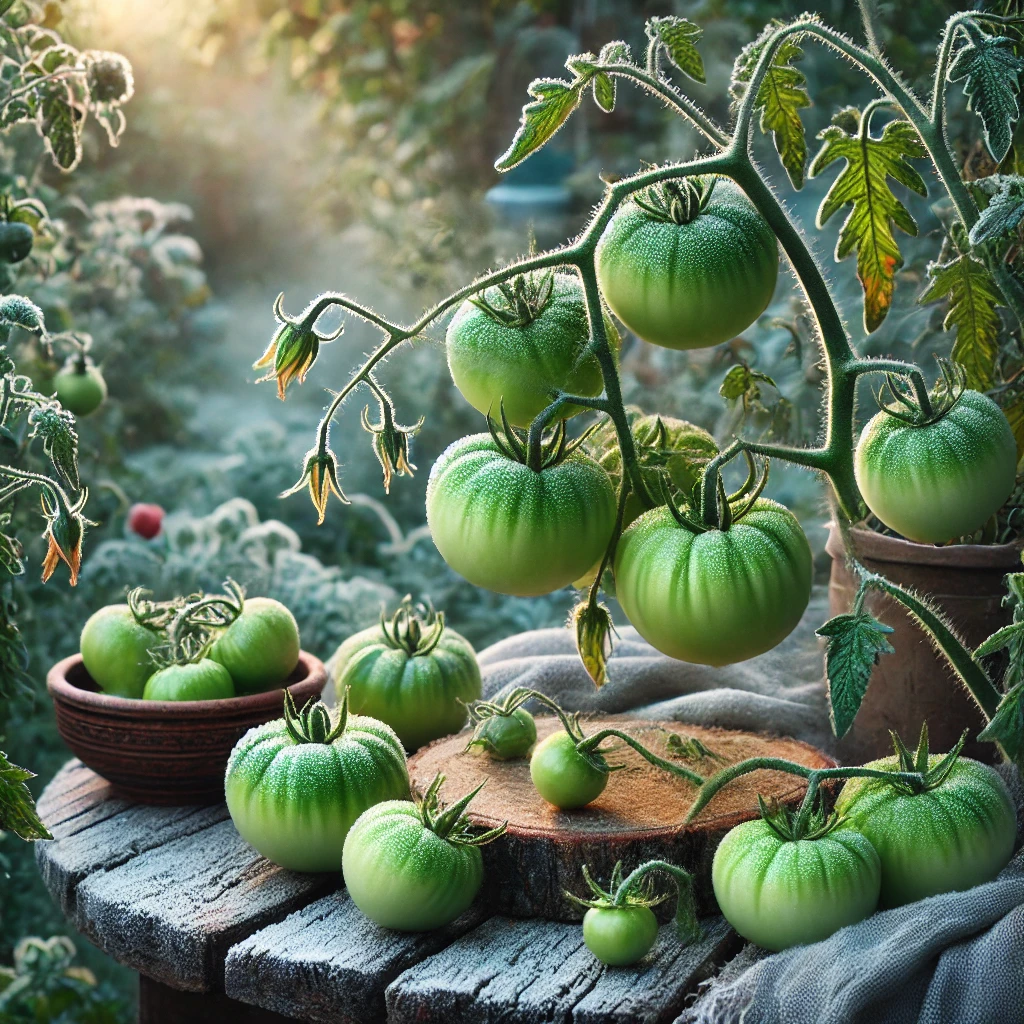Introduction
When frost threatens your tomato harvest, acting quickly to save your remaining produce is essential. Green tomatoes, which haven’t ripened due to the cold weather, are often left behind in gardens, leaving many gardeners unsure of what to do with them. Preserving these unripened tomatoes is a practical and rewarding way to ensure they don’t go to waste. Not only does this safeguard your hard work, it also opens up a world of culinary possibilities for incorporating green tomatoes into meals.
Green tomatoes are incredibly versatile and can be transformed into a variety of delicious dishes. Whether you fry, pickle, can, or freeze them, there’s no shortage of creative ways to enjoy their unique tangy flavor. By preserving them before frost hits, you can extend their usability throughout the year, allowing you to savor their taste and make the most of your garden’s bounty even during the colder months.

Table of Contents
Why Preserve Green Tomatoes?
The Versatility of Green Tomatoes in Cooking
Green tomatoes are not just for frying! They’re versatile ingredients that can be used in a wide range of recipes. Fried versions are a Southern delicacy, but they can also be made into salsas, chutneys, and sauces. These tangy fruits work wonderfully in dishes like stews, casseroles, and even as a unique addition to pies. Their tart flavor adds a special twist to many recipes, making them a valuable ingredient for creative cooks.
The Importance of Preserving Green Tomatoes
Preserving them is essential, especially when frost threatens the remainder of your harvest. By doing so, you can enjoy their distinctive taste and texture well after the growing season ends. Additionally, preserving these fruits is a sustainable practice that minimizes food waste. Whether you want to stock up for winter meals or create unique homemade gifts like jars of pickled tomatoes, preserving them offers long-term benefits.
7 Smart Ways to Preserve Green Tomatoes
Here are seven smart and practical methods for preserving tomatoes. Each technique brings out different flavors and textures, allowing you to use them in a variety of dishes throughout the year.
1. Frying Green Tomatoes
How to Fry Tomatoes:
Fried green tomatoes are a Southern favorite and simple to prepare. Start by slicing them into thick rounds. Coat the slices in a mixture of cornmeal, flour, salt, and pepper, then fry them in hot oil until golden brown on both sides. They can be served as a side dish or added to sandwiches and salads for a delicious crunch.
Benefits and Storage Tips:
Frying these tomatoes creates a crispy, savory treat that can be stored in the refrigerator for a few days. For longer storage, you can freeze them. Just layer the fried slices between parchment paper, place them in a freezer bag, and store them in the freezer for up to 3 months.
2. Making Green Tomato Salsa
How to Make Tomato Salsa:
Green tomato salsa offers a tangy and delicious flavor, making it perfect for dipping or as a topping for tacos and grilled meats. To prepare, chop the tomatoes, onions, and peppers. Add cilantro, garlic, and lime juice, then mix with salt and pepper. You can either can the salsa for long-term storage or refrigerate it for up to a week.
Benefits and Storage Tips:
This method lets you enjoy the fresh, tangy flavors of green tomatoes in a vibrant salsa form. If you make a large batch, consider canning it for extended storage. The salsa can also be frozen for up to 6 months, making it a great pantry staple year-round.
3. Pickling Green Tomatoes
How to Pickle Tomatoes:
Pickling is a time-tested preservation method for green tomatoes. Begin by slicing the tomatoes and packing them into sterilized jars with garlic, dill, mustard seeds, and peppercorns. Pour a vinegar and water brine over the tomatoes, then seal the jars. Process them in a boiling water bath for 10 minutes to ensure proper preservation.
Benefits and Storage Tips:
Pickled tomatoes develop a tangy, zesty flavor that enhances dishes like salads, sandwiches, or charcuterie boards. These pickles can be stored in a cool, dark place for up to 1 year, allowing you to enjoy the vibrant taste of green tomatoes well after frost has passed.

4. Ripening Green Tomatoes Indoors
If frost is approaching but you’re not ready to preserve your green tomatoes, you can ripen them indoors. Simply place them in a cardboard box or on a windowsill with some ventilation, and check them regularly for ripening. This method works best for tomatoes that have started to show color but are still firm.
Benefits and Storage Tips:
Ripening tomatoes indoors helps extend their shelf life, allowing you to enjoy them as fully ripe fruits. Once ripened, they can be used in sauces, salads, and other dishes. While they may not be as sweet as those grown during peak season, they’ll still be a great addition to your meals.
5. Freezing Green Tomatoes
Freezing is a simple and effective way to preserve tomatoes for later use. Start by washing them thoroughly and removing any stems. Slice or chop the tomatoes into your desired shape. Blanch them briefly in boiling water, then transfer them to an ice bath to halt the cooking process. Once cooled, spread them out on a baking sheet to freeze individually before transferring them to freezer bags.
Benefits and Storage Tips:
Freezing preserves the texture and flavor of green tomatoes. When you’re ready to use them, simply thaw and cook them in sauces, soups, or casseroles. Frozen tomatoes can be stored for up to 12 months, making this method ideal for enjoying them year-round.
6. Dehydrating Green Tomatoes
Dehydrating green tomatoes removes moisture and intensifies their flavor. Start by slicing the tomatoes into thin rounds and arrange them in a single layer on a dehydrator tray or on baking sheets in an oven set to the lowest possible temperature. Dehydrate for several hours, checking periodically until the tomatoes are completely dry and brittle.
Benefits and Storage Tips:
Dehydrated tomatoes require less storage space and can be kept for extended periods. Store them in an airtight container in a cool, dry location. To rehydrate, soak the tomatoes in warm water for a few hours. Dehydrated tomatoes are ideal for use in soups, stews, or for adding to sauces.
7. Canning Green Tomatoes
Canning is a reliable method for preserving green tomatoes, particularly for making salsas, sauces, or relishes. Start by sterilizing your canning jars. Prepare the tomatoes by slicing or dicing them, then heat them with vinegar, spices, and any other ingredients you prefer. Pack the mixture into the jars, leaving space for expansion, and process the jars in a boiling water bath for the recommended duration.
Benefits and Storage Tips:
Canning ensures that green tomatoes can be stored for months or even years when done properly. Be sure the jars are sealed tightly to prevent spoilage. Store the canned tomatoes in a cool, dark place, and they’ll be ready for use in cooking or as a thoughtful gift for others.
Table: Comparison of Preservation Methods for Green Tomatoes
| Preservation Method | Process Summary | Storage Tips | Benefits |
|---|---|---|---|
| Frying Green Tomatoes | Dredge and fry until crispy | Refrigerate for up to 4 days or freeze | Crunchy texture, versatile in dishes |
| Making Green Tomato Salsa | Chop and mix with seasonings, then can or refrigerate | Refrigerate for 1 week, freeze for 6 months | Fresh and tangy, great for gifts |
| Pickling Green Tomatoes | Pack in brine, process in water bath | Store in a cool place for 1 year | Tangy and zesty, adds flavor to meals |
| Ripening Green Tomatoes Indoors | Place on windowsill or in a box with ventilation | Use when ripe, refrigerate for short-term | Extends harvest season |
| Freezing Green Tomatoes | Wash, blanch, and freeze in bags | Freeze for up to 12 months | Convenient and long-lasting |
| Dehydrating Green Tomatoes | Slice thin and dehydrate in dehydrator or oven | Store in airtight containers | Space-saving, rehydrate for soups |
| Canning Green Tomatoes | Sterilize jars, process in water bath | Store in a cool, dark place | Long-term preservation, great for sauces |
Step-by-Step Guide for Freezing Green Tomatoes
Preparation for Freezing:
Begin by washing the tomatoes thoroughly to remove any dirt or pesticides. Remove the stems and discard any damaged parts. While you can freeze them whole, slicing or dicing them can make them more versatile for later use. If you prefer, blanch the tomatoes by immersing them in boiling water for two minutes, then transfer them to an ice bath. This step helps preserve the color, texture, and nutrients before freezing.
Freezing and Usage Tips:
To freeze green tomatoes, spread them in a single layer on a baking sheet to flash freeze. Once frozen, transfer them to freezer bags, removing as much air as possible to prevent freezer burn. Frozen tomatoes can be stored for up to 12 months. When needed, thaw them for use in soups, stews, or sauces, taking out only the amount required for your recipe.
How to Dehydrate Green Tomatoes for Storage
Drying Techniques:
To dehydrate green tomatoes, slice them into 1/4-inch thick pieces for consistent drying. Arrange the slices on dehydrator trays or a baking sheet. Set your dehydrator to 125°F (52°C) or your oven to 140°F-170°F. Drying time will vary, typically taking 6-12 hours, depending on slice thickness and moisture content. The tomatoes are ready when they are completely dry, brittle, and moisture-free.
Storage and Rehydration Tips:
After dehydrating, store the tomatoes in airtight containers such as vacuum-sealed bags, glass jars with tight-fitting lids, or mylar bags with oxygen absorbers. Keep them in a cool, dry, dark place, away from heat and sunlight, to maintain their flavor and texture. With proper storage, dehydrated tomatoes can last for several months to a year. When ready to use, rehydrate them by soaking in warm water for a few hours to restore their original texture. Alternatively, you can add them directly to recipes, allowing them to soften while cooking and absorb liquid.
Canning Green Tomatoes Safely

Canning Preparation:
Before starting the canning process, sterilize your jars and lids by boiling them or running them through a dishwasher cycle. Wash the tomatoes thoroughly, remove the stems, and choose whether to slice, dice, or keep them whole. Popular canning recipes include salsa, sauce, or relish. To preserve them and balance acidity, add spices like garlic, onions, and chili peppers, along with vinegar.
Canning Process:
Once the jars are filled with the seasoned tomatoes, place them in a large pot of water, ensuring the jars are covered by at least an inch. Bring the water to a boil and maintain it for 10 to 20 minutes, depending on your recipe and jar size. This process sterilizes and seals the jars. Afterward, carefully remove them and allow to cool on a clean surface. Once cool, check the seals to ensure they are tightly closed. Unsealed jars may spoil. Properly canned tomatoes, when stored in a cool, dark place, can last up to a year or more.
FAQs:
How to Save Tomatoes Before Frost:
To save tomatoes before frost, consider freezing, canning, pickling, or ripening them indoors.
What to Do with Tomatoes on the Vine Before a Freeze:
Before a freeze, remove them from the vine and store them in a cool place or pick them to ripen indoors.
How to Protect Tomato Plants from Frost:
Cover tomato plants with blankets, plastic sheets, or cloches to protect them from frost damage.
What is the Best Way to Store Tomatoes for Winter?
Tomatoes are best stored in a cool, dark place or ripened indoors for use in sauces and dishes later.
Will Frost Damage Tomatoes?
Yes, frost can damage tomatoes by making them mushy and inedible, so preserving them before frost is crucial.
Can You Ripen Tomatoes in Sunlight?
Yes, placing them in sunlight can help them ripen, but they should be kept in a warm, well-ventilated area.
Can You Freeze Tomatoes Without Blanching?
Yes, freezing without blanching is possible, but blanching helps preserve texture and flavor for longer storage.
What is the Best Way to Preserve Tomatoes?
The best ways to preserve them are freezing, canning, pickling, or dehydrating, depending on your preference.
How to Tell if Frost Killed Tomatoes?
Frost-killed tomatoes will show signs of shriveling, discoloration, or a mushy texture when touched.
Do Tomatoes Need to Be Picked Before Frost?
Yes, tomatoes should ideally be picked before frost to preserve their quality and avoid damage.
What is the Lowest Temperature Tomatoes Can Tolerate?
Tomatoes can tolerate temperatures as low as 32°F (0°C), but frost can severely damage them.
What Temperature is Frost?
Frost typically forms when temperatures fall below 32°F (0°C), causing water vapor to freeze on surfaces.
What to Do with Tomatoes Picked Before Frost?
Picked tomatoes can be ripened indoors or used in cooking, frying, or preserving methods.
How to Freeze Garden Tomatoes Whole?
Wash and remove the stems, place them on a baking sheet to freeze individually, then transfer them to freezer bags.
What to Do with an Abundance of Tomatoes?
Use them for frying, pickling, making salsa, or canning them into sauces.
Can You Freeze Tomatoes Straight from the Vine?
Yes, tomatoes can be frozen straight from the vine, but blanching them first improves taste and texture.
What to Do with Picked Tomatoes?
Picked tomatoes can be ripened indoors, fried, canned, or used in sauces and salsas.
Can Tomatoes on the Vine Survive Frost?
No, tomatoes on the vine typically cannot survive frost and need to be harvested before it occurs.
How to Ripen Tomatoes on the Vine?
To ripen on the vine, ensure they’re in a warm, sunny spot and protect them from cold temperatures.
Conclusion
In conclusion, preserving tomatoes before frost hits is an excellent way to extend the life of your harvest and enjoy their unique flavor throughout the year. Whether you choose to fry, pickle, can, freeze, or dehydrate them, green tomatoes can be used in a variety of dishes that bring a burst of flavor to your meals. By taking action before the frost arrives, you can make the most of your tomato crop and savor these fresh flavors long after the growing season ends. Start preserving your green tomatoes today, and enjoy their versatility in the months to come!
For more tips on thriving in your garden, you can check out 10 Proven Tips for Thriving Homalomena Care & Growth and Top 20 Most Powerful Garden Myths Debunked of All Time.


4 thoughts on “7 Easy Ways to Preserve Green Tomatoes Before Frost Hits”